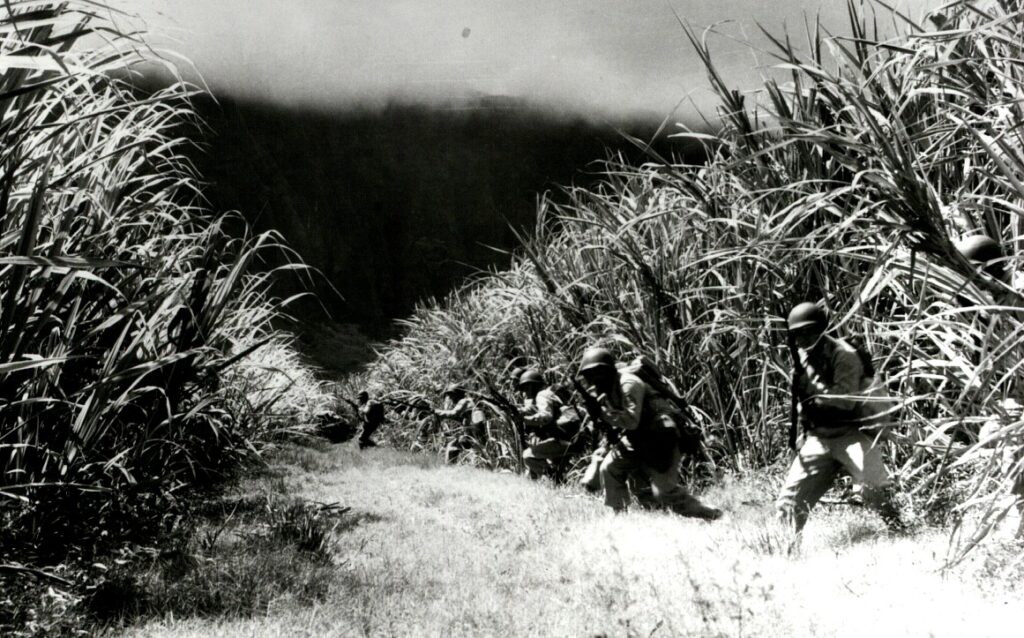Prior to World War II, Kahana and Punalu‘u Valleys were primarily used for agricultural activities. Taro, rice, and sugar cane were cultivated at the mouths of each valley. The interior portions of the valleys were heavily vegetated and relatively unused.
The Army initially leased 485.25 acres in Kahana Valley from Hui of Kahana in November 1944, retroactive to May 1943. Between 1943 and 1947, the Army acquired an additional 1,781.52 acres in the neighboring Punalu‘u Valley from various landowners through leases, licenses, and permits.
In response to an August 9, 1943 directive from the Commanding General, Hawaiian Department, Pacific Jungle Combat Training Center (CTC) was established as a school on Oahu to supplement Department Ranger and Combat School training.
It was located on the northeastern side of the island of Oahu totaling approximately 2,545 acres in the adjacent valleys of Punalu‘u and Kahana in the district of Ko‘olauloa.
Pacific Jungle CTC was also known as Unit Jungle Training Center, Unit Combat Training Center, Pacific Combat Training Center, Jungle Training, Punaluu Training Camp and Green Valley Jungle Training Camp.
Punalu‘u Valley being referred to as “Green Valley” by the Army while Kahana Valley was designated “Red Valley” during utilization of the valleys as a training area.
An Army-built coral-surfaced service road is still referred to as “Green Valley Road” by area residents. This road is also designated by Oahu Civil Defense Agency as an evacuation route to allow coastal inhabitants access to higher ground in the event of a tsunami.
Beginning in September 1943 (during World War II), this property was used as a unit-level jungle combat training center. The Center was divided into three courses: Red, Blue, and Green.
Basic warfare training was conducted at the Red and Blue courses while advanced warfare training and Instructor Jungle Training School were conducted at the Green course.
Subjects taught during a one-week course included jungle first aid and evacuation, hand-to-hand combat training, construction and passage of wire entanglements, booby traps, patrolling and ambushing, assault of Japanese fortified areas, combat reaction proficiency, and jungle living.
The Army reportedly constructed Japanese villages and pillboxes for training purposes. Temporary barracks, a mess hall, a bakery, and shower facilities were also erected though no longer exist.
Advanced training on Green Course was discontinued on 28 May 1944 after only its second class as it became necessary to utilize the course for basic jungle warfare training of divisions being staged for the Western Carolines operations.
Jungle warfare was de-emphasized as the war progressed from tropical regions to areas where jungle fighting was not a primary consideration.
All jungle training centers became known as Unit Combat Training Centers in March 1945. On month later, it was redesignated as Pacific Combat Training Center to deemphasize jungle warfare. Over 241,000 men received basic, advance, or instructor training at the center.
Munitions known to have been used or recovered at the site include 75mm armor piercing rounds, 2.36-inch rockets, MKII hand grenades, rifle grenades, 105mm high explosive rounds, 81mm high explosive and practice mortar rounds, and small arms.
Postwar plans called for closing the majority of the center except for the Green Course in Punalu‘u Valley, which was to be retained to fulfill the Army’s postwar training requirements.
The Army re-opened Punalu‘u Valley on April 1, 1946 to provide emergency shelter for area residents displaced by a tsunami. Tents were erected for sleeping quarters, to render medical treatment, and to feed approximate 1,700 individuals.
Parcels in Kahana Valley were returned to previous landowners in August 1946. The leases, licenses, and permits for parcels in Punalu‘u Valley terminated between April 1945 and November 1950 and were reverted back to previous owners.
The Punalu‘u Valley parcels are primarily owned by Kamehameha Schools. The Kahana Valley parcels are now owned by the State of Hawai‘i and managed by the DNLR, Division of State Parks.
The Kahana Valley parcels are located in the Ahupuaʻa ʻO Kahana State Park. The park was established as a “living park” with the primary purpose to nurture and foster native Hawaiian cultural traditions and the cultural landscape of rural windward Oahu. (All here is from the Army Corps of Engineers.)





































